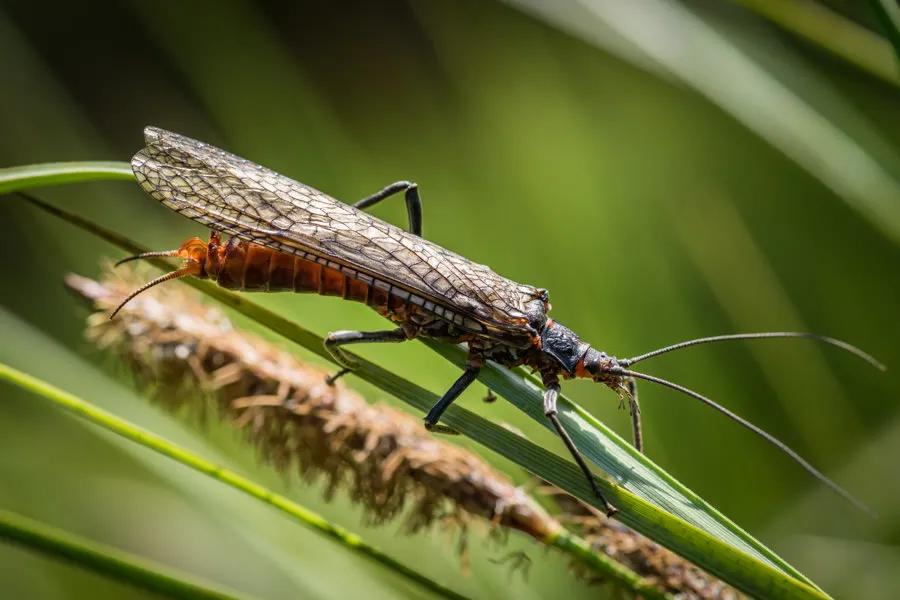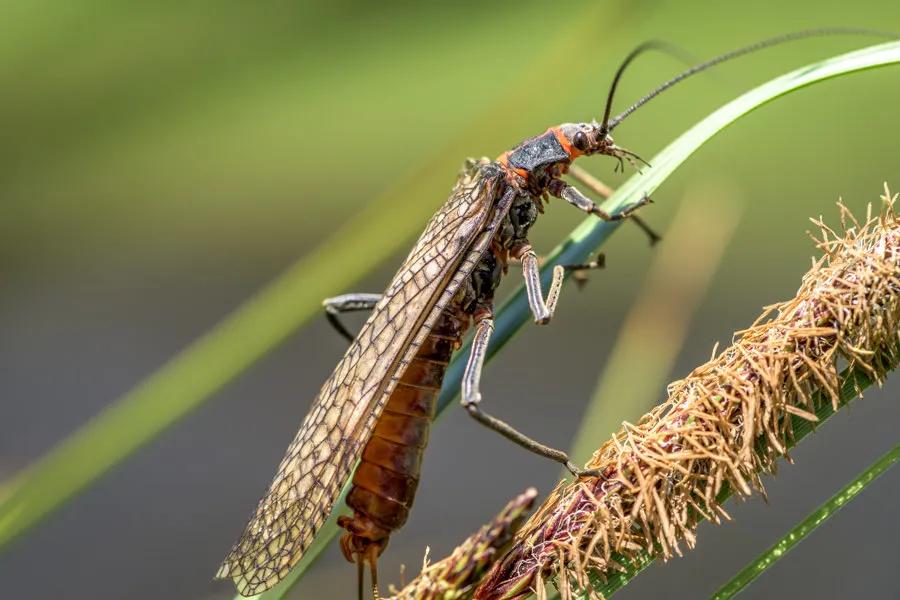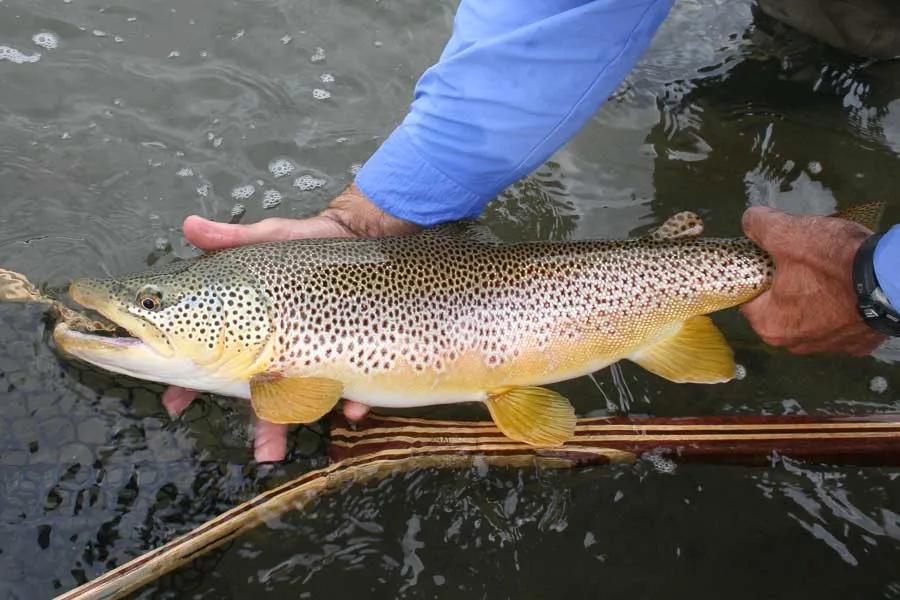
Montana’s rich and varied wild trout fisheries offer anglers year round fishing opportunities. While it is difficult to elevate any one time of the year as the “best” time to fish the Big Sky state’s blue ribbon rivers, there is no doubt that the most anticipated time of year coincides with the emergence of the legendary salmonfly hatch.
Salmonflies, which derive their name from their salmon orange abdomens as adults, are the largest aquatic insects found in our local rivers. They are a type of stonefly that are found in rocky and swift flowing rivers and are part of the Pteronarcys genus. Salmonflies dwarf most other aquatic insects and often exceed 2 inches in length. It is the large size of the insect that garners so much attention from fly fisherman. While smaller trout will spend their day hunting much smaller morsels of food; large trout tend to eat large meals less frequently. Most of the year anglers in search of truly large trout need to fish subsurface patterns such as streamers that imitate small fish. The salmonfly hatch is one of the rare times when even the largest fish in the river will be tempted to feed on the surface to intercept the oversized adult insects.

As juveniles salmonflies spend 3-4 years as immature nymphs in the river before hatching into adults. Although the nymphs can be a year round food source, they become much more accessible to trout just before the emergence when they migrate towards the banks.
Salmonflies begin hatching in lower elevation rivers that warm faster such as the Smith and as late as mid July on the Upper reaches of the Yellowstone River inside of Yellowstone National Park. Although the hatch can be encountered in different rivers over the course of several weeks, on any one section of river they are only on the water as adults for a few days each season.

Salmonflies prefer a specific habitat within Montana rivers. They require clean, cold, well oxygenated water. They are always found in the most abundance in the swifter sections of rivers that are home to large boulders vs. finer gravel associated with lower gradient sections of rivers.
Several days before the hatch begins the large nymphs will begin migrating from the swift midriver locations towards the banks. The migration is a great time to target larger fish on subsurface nymph imitations. When the emergence begins the nymphs climb out of the water onto rocks or vegetation and then molt into adults. Often nymphal shucks will be found along the waters edge during his time. Once the salmonflies have hatched into adults they can easily be seen flying through the air or flopping on the water as they flutter their wings. After mating flights the females will fall to the water to drop their egg sacs back into the river.
Tip 1: Do Your Best to Time the Hatch
One of the most important elements when fishing the salmonfly hatch is to actually find the hatch. Because the insects hatch in such a short emergence window on any one stretch of river they can sometimes be difficult to find. To complicate matters, each year the insects can hatch at a slightly different time during the season. Generally on higher water years when water temperatures remain cold longer the emergence is delayed while on lower water years the hatch begins earlier. What is generally the same from year to year is the relative order of where the hatch is found. The hatch often makes its first appearances in Montana waters in the Smith River canyon in mid to late May. In early June expect to find them on the Lower Madison below Ennis Lake and then in Mid June they hit the Big Hole. Generally the Upper Madison and Upper Yellowstone in Paradise Valley will see salmonflies in late June or early July. The last appearance is generally on the Yellowstone River inside of Yellowstone Park.
Salmonflies generally start on the lower reaches of a river where waters warm earlier. Once the hatch first appears it tends to move up river day by day once the colder headwaters warm up.
If you are chasing the salmonfly hatch pay close attention to water temperatures and fishing reports. Word gets out fast once the hatch begins. If you are fishing year after year you can also begin to predict the pattern of where the hatch will show up next.

Tip 2: Pay Your Dues and Put Your Time In
Just because you find where the salmon flies hatching doesn’t mean that you will be catching lots of big wild trout. Most of the time you actually catch fewer fish when chasing salmonflies. Keep in mind that these are large meals so trout basically feed less often since their meals are much larger.
The insects are so large that fish can often get full on them resulting in a lower catch rate. The real allure of fishing over the salmonfly hatch is the potential for catching really large fish. Once trout get really large they spend more energy to rise to the surface than a small trout. Big trout start to look for big meals like sculpins and crayfish and are less likely to be interested in rising to the surface for a small mayfly. Salmonflies are very large and provide a lot of calories and as a result even the biggest trout in the river will often be enticed to the surface to intercept them.
Even though you are always in the game for one of the biggest trout in the river during the hatch doesn’t mean that it will happen often. If you want to catch a really big trout on a salmon fly dry fly you need to invest a lot of time chasing the hatch. When that one special monster finally inhales your size 4 dry fly all the hard work pays off!

Tip 3: Fish Before and After the Hatch
Some of the most consistent fishing when chasing the hatch tends to occur a few days before the hatch begins and then a few days after it ends. Leading up to the hatch the huge nymphs begin migrating into shallow water where they will eventually climb out onto rocks and grass along the banks to molt into adults. During this nymphal migration big trout will be on the hunt and the subsurface nymph fishing can produce big results.
A few days after that hatch can also be very productive. It can take a few days for fish to digest after a gluttonous feeding spree at the peak of the hatch. When trout go back on the hunt they still remember the big bugs even though they may not be on the water. Fishing a big dry fly a few days after the hatch has moved on can often produce consistent results and larger than average trout.
Chasing the salmonfly hatch isn’t for the faint of heart. The “big bug” often attracts lots of other anglers and there will be many days with huge insects flopping on the water while the trout below are already full and not feeding. Some days you will gear up to chase the hatch only to find lots of other anglers and no salmonflies. Chasing the hatch will most certainly result in numerous points of frustration and disappointment but if you keep swinging for the fences sooner or later you might just hit a home run!
